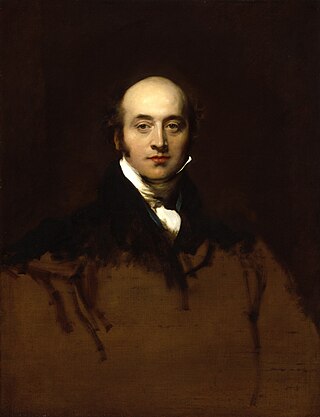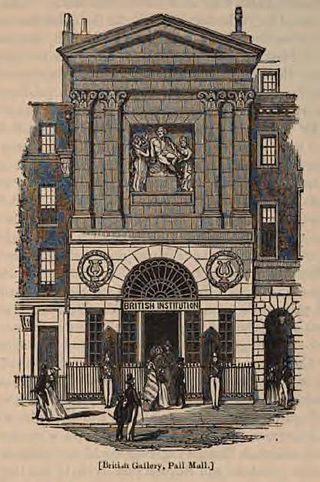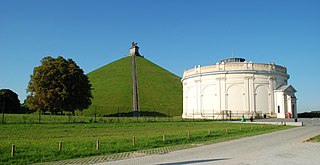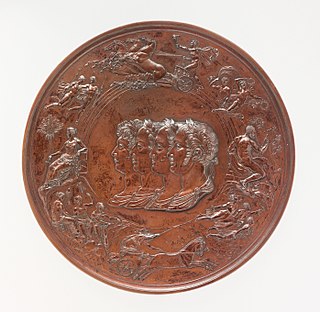
Sir Thomas Lawrence was an English portrait painter and the fourth president of the Royal Academy. A child prodigy, he was born in Bristol and began drawing in Devizes, where his father was an innkeeper at the Bear Hotel in the Market Square. At age ten, having moved to Bath, he was supporting his family with his pastel portraits. At 18, he went to London and soon established his reputation as a portrait painter in oils, receiving his first royal commission, a portrait of Queen Charlotte, in 1789. He stayed at the top of his profession until his death, aged 60, in 1830.

John Constable was an English landscape painter in the Romantic tradition. Born in Suffolk, he is known principally for revolutionising the genre of landscape painting with his pictures of Dedham Vale, the area surrounding his home – now known as "Constable Country" – which he invested with an intensity of affection. "I should paint my own places best", he wrote to his friend John Fisher in 1821, "painting is but another word for feeling".

Daniel Maclise was an Irish history painter, literary and portrait painter, and illustrator, who worked for most of his life in London, England.

General Sir Edward Paget was a British Army officer.

Abraham Cooper (1787–1868) was a British animal and battle painter.

Richard Ansdell was a British painter of animals and genre scenes.

Jan van den Hoecke was a Flemish painter, draughtsman and designer of wall tapestries. He was one of the principal assistants in Rubens' studio in the 1630s. He later traveled to Italy where he resided for a decade in Rome. He subsequently worked as a court painter in Vienna and Brussels. Jan van den Hoecke was a versatile artist who created portraits as well as history and allegorical paintings.
4 William Salter was an English portrait painter of the 19th century. His best known work was a painting of 83 people at a banquet in 1836 organised by the Duke of Wellington to celebrate their victory at the Battle of Waterloo. The painting is called The Waterloo Banquet 1836 and today is at Apsley House.

The British Institution was a private 19th-century society in London formed to exhibit the works of living and dead artists; it was also known as the Pall Mall Picture Galleries or the British Gallery. Unlike the Royal Academy it admitted only connoisseurs, dominated by the nobility, rather than practising artists to its membership, which along with its conservative taste led to tensions with the British artists it was intended to encourage and support. In its gallery in Pall Mall the Institution held the world's first regular temporary exhibitions of Old Master paintings, which alternated with sale exhibitions of the work of living artists; both quickly established themselves as popular parts of the London social and artistic calendar. From 1807 prizes were given to artists and surplus funds were used to buy paintings for the nation. Although it continued to attract members and visitors, in 1867, when the lease on its quarters expired, instead of renewing the society wrapped up its affairs.
James Graham (1791–1845) was an Irish non-commissioned officer (NCO) in the British Army during the Napoleonic Wars, recognised as the "bravest man in the army" by the Duke of Wellington. Serving in the Coldstream Guards, he was commended for his gallantry during the defence of Hougoumont, at Waterloo. Graham saved the life of an officer, and his own brother, and was among the small group responsible for closing the North Gate at Hougoumont after a French attack – an act which won the Duke of Wellington's encomium. He was rewarded with a specially cast gallantry medal and an annuity. After later serving in the 12th Royal Lancers, Graham was discharged in 1830 for ill health, and died at the Royal Hospital Kilmainham in 1845.

George Jones was a British painter, and Keeper of the Royal Academy, most famous for his paintings of military subjects.

George Arnald was a British painter who specialised in landscapes, including topographical views to illustrated county histories. He is best known for his celebrated painting depicting the Battle of the Nile.

Religion saved by Spain is an oil on canvas painting produced between 1572 and 1575 by Titian, an Italian master of the Venetian school, commemorating the Battle of Lepanto in 1571. It is one of his later works, and is considered to be an outstanding piece. Other titles are Spain succoring Religion or Religion assisted by Spain.

The Panorama of the Battle of Waterloo is a rotunda in Belgium that houses a monumental panoramic painting depicting the Battle of Waterloo. The neoclassical building is located immediately to the north of the Lion's Mound on the battlefield of the Battle of Waterloo in the municipality of Braine-l'Alleud in the Belgian province of Walloon Brabant.

The Battle of Waterloo: The British Squares Receiving the Charge of the French Cuirassiers is an oil on canvas painting by French artist Henri Félix Emmanuel Philippoteaux, from 1874. It measures 99 × 155 centimetres (39 × 61 in). It is held at the Victoria and Albert Museum, in London.

The Chelsea Pensioners reading the Waterloo Dispatch, originally entitled Chelsea Pensioners Receiving the London Gazette Extraordinary of Thursday, June 22, 1815, Announcing the Battle of Waterloo, is an oil painting by David Wilkie, commissioned by Arthur Wellesley, 1st Duke of Wellington in August 1816.
The Wellington Collection is a large art and militaria collection housed at Apsley House in London. It mainly consists of paintings, including 83 formerly in the Spanish royal collection, given to Arthur Wellesley, 1st Duke of Wellington, who was Prime Minister as well as the general commanding the British forces to victory in the Napoleonic Wars. It also includes his collection of furniture, sculpture, porcelain, the silver centrepiece made for him in Portugal around 1815, and many other artworks and memorabilia relating to his career.

The Waterloo Medal was designed by Italian-born sculptor Benedetto Pistrucci. He worked on it from 1819 to 1849, when the completed matrices were presented to Britain's Royal Mint. The medal was commissioned by the British Government in 1819 on the instructions of the Prince Regent ; copies were to be presented to the generals who had been victorious in the 1815 Battle of Waterloo, and to the leaders of Britain's allies. As most of the intended recipients had died by 1849, and relations with France had improved, the medals were never struck, though modern-day editions have been made for sale to collectors.

Triumph of Frederick Henry, Prince of Orange is a painting by the Flemish painter Jacob Jordaens, signed and dated at the bottom left "J JOR fec / 1652". It is located in the Oranjezaal in the Huis ten Bosch in The Hague, The Netherlands.

The Last Muster is an 1875 oil painting by Sir Hubert von Herkomer, based on his wood engraving Sunday at the Chelsea Hospital published in The Graphic on 18 February 1871. The painting is in the Lady Lever Art Gallery in Port Sunlight, Wirral.

















